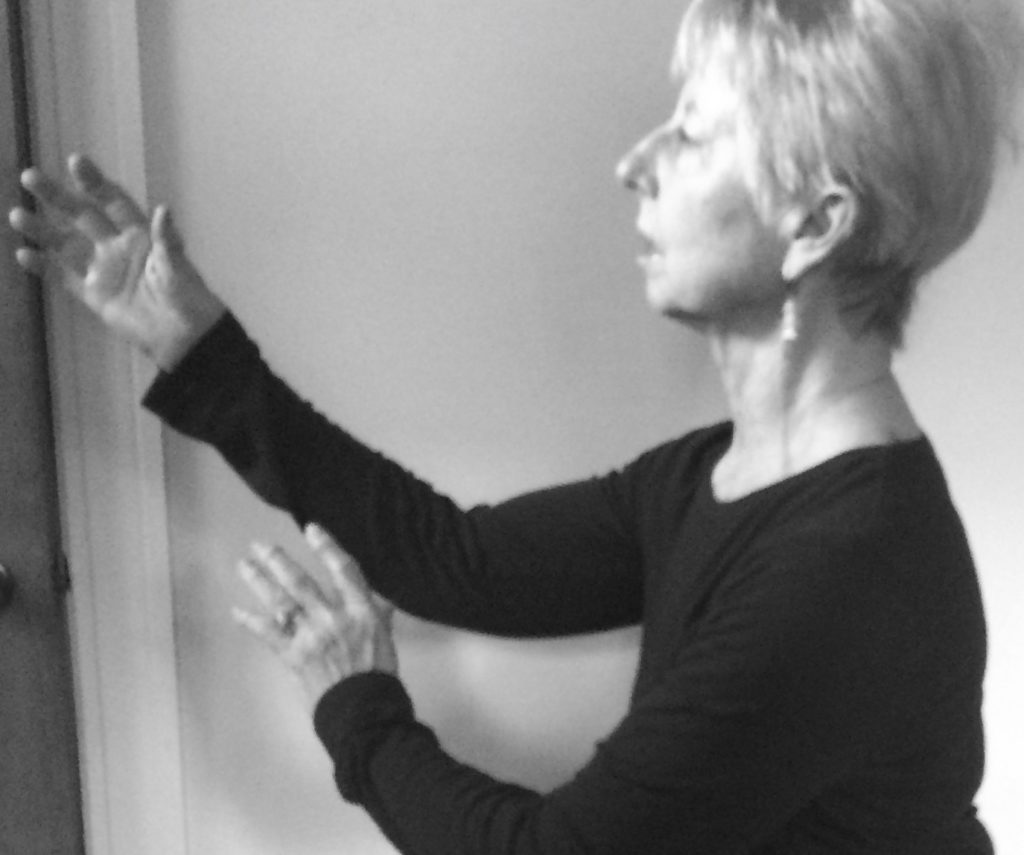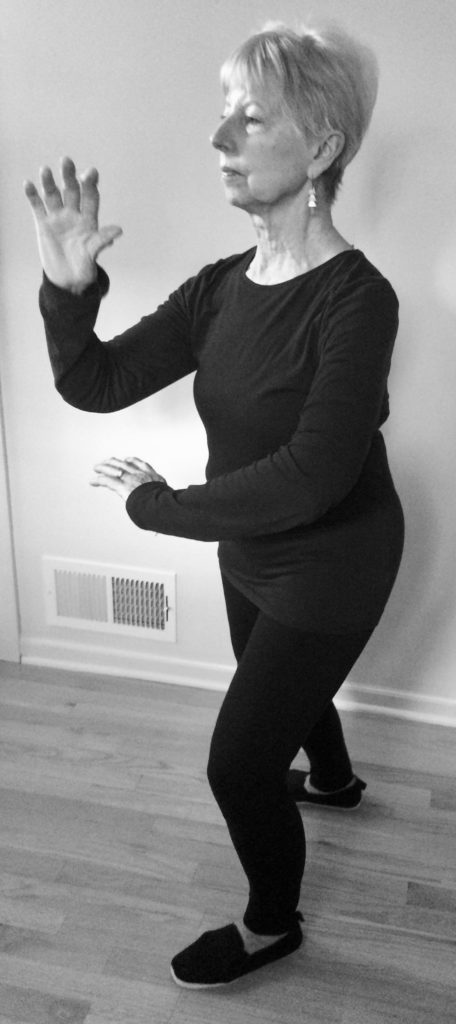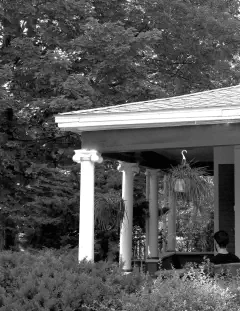By Teddy Robertson
“Breathe from the diaphragm,” says Beverly, my tai chi instructor. “Clear your mind; try to go slowly,” she reminds us before we begin. We never go slowly enough.
We stand in two rows in a large room, the dining hall in a senior center. Some wear the thin-soled martial arts slippers that help in tai chi’s turns and kicks, glides and slides.
Through its floor-to-ceiling windows a hummingbird jabs at the orange and purple blooms on stalks of bird of paradise that edge the building. Across the grass between the fig and palm trees I can glimpse the gray blue Pacific in the distance; when the doors are open we can hear the muffled clang of the bell buoy.
This is January on the South Bay coast west of Los Angeles, not my home in Flint. I get distracted.

Teddy Robertson back home in Flint (Photo by Jan Worth-Nelson)
We bow and then raise our outstretched arms to clasp our left hand over our right fist, the tai chi salute. At some point in the next half hour—if I can corral my wandering thoughts—my mind will float away from my body.
Part of tai chi’s allure for me has been the promise of settling the mind, but I’ve come to love the exercise, how it feels in my body.
I first learned about tai chi through a class taught one semester at the UM-Flint Rec Center. I learned about “the empty leg” and how to “sink the chest.” Different concepts and techniques after years of yoga. I found YouTube videos and began to follow articles online.
My first winter in Southern California, I saw a group of 20 or so people in a nearby park moving in slow motion like the videos I’d watched. I looked up the park activities online, but the tai chi group had disbanded. Another group met in a different park, but it was too far to drive. I checked Meetup—more than a dozen tai chi groups were listed but all were nearly an hour away. That’s Los Angeles.
Then by chance I stopped in at a nearby senior center and on the message board was a flyer for a tai chi class taught there, a weekly session in something called “the Yang style long form.”
It works for seniors
I joined a group of eight learners—the oldest one turns 90 this year and another, aged 83, walks with a cane. For an hour on Thursday mornings we move silently through a routine that requires 10 kicks standing on one leg, several with turns on one foot.
No one has ever fallen. We don’t kick very high.
The Yang style long form turned out to be a series of 103 moves (or more, depending on how they are counted), many with flowery names: grasp the bird’s tail, play the lute, repulse the monkey, fighting tiger, fair lady works the shuttles, the snake creeps down, the golden cock stands on one leg.
I see the brushstrokes of a Chinese painting.
In fact, it’s a martial art

“The promise of settling the mind” — (Photo by Jan Worth-Nelson)
Don’t be fooled. Tai chi is an internal martial art practiced for health and relaxation, but its full name, t’ai chi ch’uan, can be translated as “Supreme Ultimate Fist.” Basic moves like “ward off” and “parry and punch” come from combat and self-defense, but those with the flowery names do also. Beverly reminds us: you are blocking, you are striking, you are kicking an opponent. Keep space between your feet so you won’t be knocked off balance.
Tai chi’s modern history is traced to Chen village in Wenxian County, Henan Province, in central China. A 17th century warrior and master of martial arts named Chen Wangting is credited with creating tai chi.
The art remained in Chen family and their village for centuries. People came to the village to learn the art (and still do today). An outsider named Yang Lu-chan (1799-1872) studied the Chen practice and developed the style that is named after him. More styles developed from the Chen form. You can find a bewildering tree of lineages of tai chi styles in Wikipedia.
During China’s Civil War many traditional tai chi teachers emigrated or ceased activity, but in 1949 the People’s Republic government established the Chinese Sports Committee. The Committee developed hybrid forms of tai chi that were easier to learn and practice and promoted group tournament; the government encouraged public practice.Qigong, Chinese medicine’s ancient system of physical exercises and breathing control (and used for tai chi training) also came under state regulation.
America embraces tai chi
Tai chi spread in America in the wake of the martial arts interest that exploded in the 1970s. Boomers have embraced tai chi for health; the Mayo Clinic recommends it to reduce stress and some hope its practice will prove beneficial against Alzheimer’s.
Each class tests me—how much of the entire form will my body remember? I’ve got the short opening section down pat, melded into my muscle memory. I’m doing better with the middle section; sequences of moves repeat and sometimes if I can remember how one arm or leg goes, the next moves will come to me. At some point in the third and longest section I will sneak a glance at Beverly; where are we? Did I miss “snake creeps down”?
It takes our group 30 minutes or more to do the entire Yang long form. If we go slowly enough. When we finish we repeat the salute and bow. We clap for our instructor and ourselves. I am elated; for a few moments my arthritic body feels light and fluid again.
Even when my kicks on one leg wobbled or I forgot half of the last section, I feel satisfaction. Even if my errant mind got distracted, I am peaceful.
Theoretically, you can practice it anywhere
Real devotees say you can practice tai chi anywhere. Allen Ginsberg dedicated a poem, “In My Kitchen in New York;” September 5,1984, to his tai chi master. It turned out to be a wry commentary about practicing in his tiny Manhattan apartment and it’s recorded on video.
The first stanzas go like this:
Bend knees, shift weight
Picasso’s blue deathhead self portrait
tacked on refrigerator door
This is the only space in the apartment
big enough to do t’ai chi
Straighten right foot & rise–I wonder
if I should have set aside that garbage
pail
Raise up my hands & bring them back to
shoulders–The towels and pyjama
laundry’s hanging on a rope in the hall
Push down & grasp the sparrow’s tail
Those paper boxes of grocery bags are
blocking the closed door
Turn north–I should hang up all
those pots on the stovetop
Am I holding the world right? That
Hopi picture on the wall shows
rain & lightning bolt
Turn right again–thru the door, God
my office space is a mess of
pictures & unanswered letters
I better concentrate on what I’m doing
weight in belly, move by hips
No, that was the single whip–that apron’s
hanging on the North wall a year
I haven’t used it once
Except to wipe my hands–the Crane
spreads its wings have I paid
the electric bill?[1]
Yeah, Allen, not enough space and too many distractions at home for me too. But the poem consoles me. Each week I join my tai chi friends in warm expectation; I see the ocean and hear the muffled clang of the bell buoy. We bow, raise hands and salute, we try again.
EVM columnist Teddy Robertson can be reached at teddyrob@umflint.edu. She is back in Flint and doing tai chi poses whenever she can in her Mott Park home.
Editor’s Note: Saturday, April 27, is World Tai Chi Day, observed in hundreds of cities in over 80 nations, spanning six continents, according to worldtaichiday.org. The day will include mass teach-ins and exhibitions held around the planet.
Banner Photo: Catalina Island and the Pacific, coast of LA (Photo by Jan Worth-Nelson)


You must be logged in to post a comment.